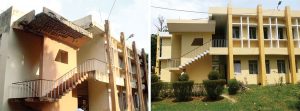
Md. Nahidul Islam
Managing Partner, ALTRA Construction Co.
ALTRA provides Waterproofing & Protective Coating solutions for all areas. The range of waterproofing coats consists ShaliRust Off, ShaliPrime ZnR, ShaliBond concrete, Shalifix EM, ShaliGrout EI, ShaliFix RM, ShaliCryl 215.
The three major signs of distress in a concrete structures are cracking, spalling, and disintegration. To achieve durable repairs, it is necessary to consider the factors affecting the design and selection of repair systems as parts of a whole, or as components of a composite system.
Cracking is one of the most misunderstood problems of concrete, as it is generally regarded as indicative of defective design or materials. Methods of repairing cracks include bonding with epoxies, routing and sealing, stitching, external stressing, grouting, blanketing, use of overlays, etc. Repairing cracks does not usually involve strengthening. In a structure showing spalling and disintegration, it is usual to find that there have been substantial losses of section and/or pronounced corrosion of reinforcement. Hence, the repair involves some requirement for restoration of lost strength.
Development of cracking in concrete is due to tensile stress and can be arrested by removing these stresses. Further, the cracks can be closed by inducing a compressive force, sufficient to overcome the tension and to provide a residual compression. The success of repair and rehabilitation of a structure depends on the specific plans designed for it.

Repairing cracks in concrete structures
Protection, Repair and Rehabilitation procedures depend on evaluating the condition of concrete in the structure; relating the condition of the concrete to the underlying causes of distresses; selecting appropriate repair materials and methods for any deficiency found; and using the selected materials and methods to repair or rehabilitate the structure.
The following factors affecting the durability of structures should be taken into account for both new concrete constructions and for deteriorated structures:
» Quality of construction
» Lack of waterproofing treatment
» Poor maintenance, blocked drain pipes
» Lack of proper slope causing stagnation of water
» Leaking pipe joints.
The compatibility of materials in repair systems and the increased need for performance specifications are important considerations. A holistic model for deterioration takes into account the effect of both the scientific facts and the experimental knowledge of environmental factors, and how they affect each component of the structure. To achieve durable repairs, it is necessary to consider the factors affecting the design and selection of repair systems as part of a whole or as components of a composite system.
The reason why repairs fail is due to improper understanding of the structure and causes of the distresses. Once the reasons are identified, a proper repair strategy can be worked out by a qualified civil engineer.
Penetration of corrosive substances leads to further corrosion of the steel reinforcements. As the rust has more volume then the original steel bar, the rust causes tension in the surrounding concrete. As the cover of concrete is limited on the outer side, the resultant tensile force causes crack formations, and the cracks permit easier entry of water and oxygen to form more rusting, resulting in increase in the volume and size of the cracks, which get wider and wider. As a result of this, the surrounding concrete becomes partly disintegrated, which finally causes spalling.
Repair of a township with severe spalling
Repair involves:
» Removing all the damaged / cracked / spalled concrete by tapping with light hammer / chipping with chisel / high pressure water jets / compressed air
» Cleaning and removing all loose and defective concrete / materials
» Cleaning all the corroded / rusted reinforcement bars upto 28 mm diameter
The above can be achieved by the following processes:
» Using rust remover ShaliRust Off of STP
» Mixing extra reinforcement as required by welding
» Applying epoxy resin-based approved make of primer ShaliPrime ZnR of STP
» Applying a single coat of epoxy resin-based bonding agent ShaliBond concrete of STP
» Fixing standard injection nozzles of 10/12 mm diameter
» Including drilling holes of required diameter for the nozzles at 300mm spacing along the crack
» Sealing the nozzle from sides with epoxy mortar Shalifix EM
» Injecting through the fixed nozzle epoxy injection resin grout ShaliGrout EI of STP
» Applying pre-packed cementitious patch repair mortar ShaliFix RM of STP
» Applying surface protection, exterior paint coating ShaliCryl 215 of STP
ALTRA Construction Co.


